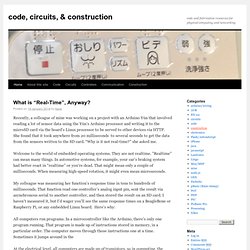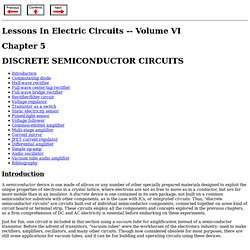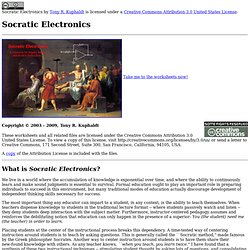

Converting ATX Power Supply to Lab Bench Power Supply » Jumper One.
Robots. Alpha Examples - Electric Circuits. Détecteur optique d'éclairs ou flash pour déclenchement photographique ou flash esclave. Code and fabrication resources for physical computing and networking. There are several ways to save data from a sensor attached to an Arduino.

If you’re connected to a personal computer, you can simply send the data from the Arduino to the personal computer serially, and save it to a file. If you’ve got an SD card attached to the microcontroller, you can save the data to the card. Or, if you have access to the internet and a device that can connect to a server, you can save the data to a server. In the tutorial below, you’ll read a DHT11 temperature and humidity sensor and log data in three ways: Serial transmission to a personal computer, and serial capture to a file.Saving data to an SD card mounted on the ArduinoHTTP upload to pachube.com via an Ethernet shield or Ethernet Arduino.
Hardware you need: personal computerEthernet Arduino and USB-to-serial connector, or Arduino Uno and Ethernet shield (or equivalents)SD Micro cardDHT11 temperature and humidity sensor10-kilohm resistor Software you need: Concepts you should know: Connecting the sensor Update. Cours INF1995. Maths-sciences.net. Volume VI (Experiments) - Chapter 5. Introduction A semiconductor device is one made of silicon or any number of other specially prepared materials designed to exploit the unique properties of electrons in a crystal lattice, where electrons are not as free to move as in a conductor, but are far more mobile than in an insulator.

A discrete device is one contained in its own package, not built on a common semiconductor substrate with other components, as is the case with ICs, or integrated circuits. Thus, "discrete semiconductor circuits" are circuits built out of individual semiconductor components, connected together on some kind of circuit board or terminal strip. These circuits employ all the components and concepts explored in the previous chapters, so a firm comprehension of DC and AC electricity is essential before embarking on these experiments. Just for fun, one circuit is included in this section using a vacuum tube for amplification instead of a semiconductor transistor. Commutating diode. Volume III - Semiconductors : All About Circuits. Volume II - AC : All About Circuits.
Numbers and symbols : NUMERATION SYSTEMS. The expression of numerical quantities is something we tend to take for granted.

This is both a good and a bad thing in the study of electronics. It is good, in that we're accustomed to the use and manipulation of numbers for the many calculations used in analyzing electronic circuits. On the other hand, the particular system of notation we've been taught from grade school onward is not the system used internally in modern electronic computing devices, and learning any different system of notation requires some re-examination of deeply ingrained assumptions.
First, we have to distinguish the difference between numbers and the symbols we use to represent numbers. A number is a mathematical quantity, usually correlated in electronics to a physical quantity such as voltage, current, or resistance. IRRATIONAL NUMBERS: π (approx. 3.1415927), e (approx. 2.718281828), square root of any prime COMPLEX NUMBERS: 3 - j4 , 34.5 ∠ 20o. Playground - Electronics. [Composant] Le NE555 - Electronique - Tutoriels robotique - Robotix.
Projetsinteraction [DokuWiki] Lessons In Electric Circuits. A free series of textbooks on the subjects of electricity and electronics Copyright (C) 2000-2015, Tony R. Kuphaldt These books and all related files are published under the terms and conditions of the Design Science License. These terms and conditions allow for free copying, distribution, and/or modification of this document by the general public. A copy of the Design Science License is included at the end of each book volume. As an open and collaboratively developed text, this book is distributed in the hope that it will be useful, but WITHOUT ANY WARRANTY; without even the implied warranty of MERCHANTABILITY or FITNESS FOR A PARTICULAR PURPOSE. Access individual volumes, I through VI: Edition numbers reflect major structural changes to a book volume such as the addition of new chapters, the substantial expansion of existing chapters, or a change in markup language (source code formatting).
"Last revised" dates reflect non-trivial changes only. Note to instructors: <--- Click Here! Socratic Electronics. Socratic Electronics by Tony R.

Kuphaldt is licensed under a Creative Commons Attribution 3.0 United States License. Take me to the worksheets now! Copyright © 2003 - 2009, Tony R. Kuphaldt These worksheets and all related files are licensed under the Creative Commons Attribution 3.0 United States License. A copy of the Attribution License is included with the files. What is Socratic Electronics? We live in a world where the accumulation of knowledge is exponential over time, and where the ability to continuously learn and make sound judgments is essential to survival. The most important thing any educator can impart to a student, in any context, is the ability to teach themselves.
Placing students at the center of the instructional process breaks this dependency. Volume VI - Experiments : All About Circuits.